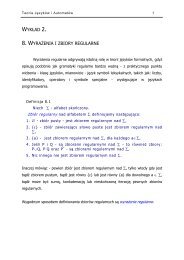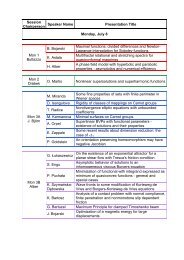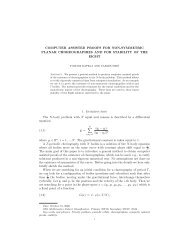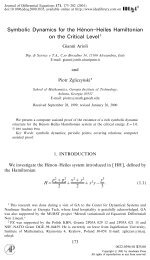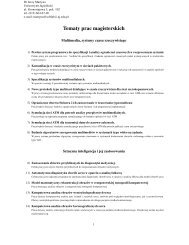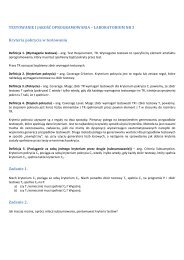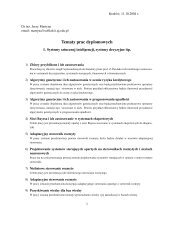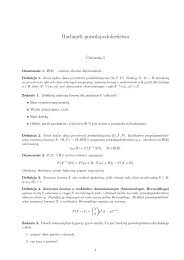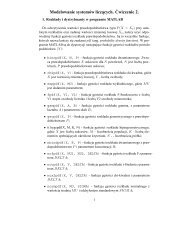Interview with Michael Atiyah and Isadore Singer
Interview with Michael Atiyah and Isadore Singer
Interview with Michael Atiyah and Isadore Singer
Create successful ePaper yourself
Turn your PDF publications into a flip-book with our unique Google optimized e-Paper software.
INTERVIEW<br />
lution, which says that the Laws of Nature<br />
are written in the language of mathematics.<br />
Why is it that the objects of mathematical<br />
creation, satisfying the criteria of<br />
beauty <strong>and</strong> simplicity, are precisely the<br />
ones that time <strong>and</strong> time again are found to<br />
be essential for a correct description of the<br />
external world? Examples abound, let me<br />
just mention group theory <strong>and</strong>, yes, your<br />
Index Theorem!<br />
SINGER There are several approaches in<br />
answer to your questions; I will discuss<br />
two. First, some parts of mathematics were<br />
created in order to describe the world<br />
around us. Calculus began by explaining<br />
the motion of planets <strong>and</strong> other moving<br />
objects. Calculus, differential equations,<br />
<strong>and</strong> integral equations are a natural part of<br />
physics because they were developed for<br />
physics. Other parts of mathematics are<br />
also natural for physics. I remember lecturing<br />
in Feynman’s seminar, trying to<br />
explain anomalies. His postdocs kept<br />
wanting to pick coordinates in order to<br />
compute; he stopped them saying: “The<br />
Laws of Physics are independent of a coordinate<br />
system. Listen to what <strong>Singer</strong> has to<br />
say, because he is describing the situation<br />
<strong>with</strong>out coordinates.” Coordinate-free<br />
means geometry. It is natural that geometry<br />
appears in physics, whose laws are<br />
independent of a coordinate system.<br />
Symmetries are useful in physics for<br />
much the same reason they’re useful in<br />
mathematics. Beauty aside, symmetries<br />
simplify equations, in physics <strong>and</strong> in mathematics.<br />
So physics <strong>and</strong> math have in common<br />
geometry <strong>and</strong> group theory, creating a<br />
close connection between parts of both<br />
subjects.<br />
Secondly, there is a deeper reason if your<br />
question is interpreted as in the title of<br />
Eugene Wigner’s essay “The<br />
Unreasonable Effectiveness of<br />
Mathematics in the Natural Sciences” 3 .<br />
Mathematics studies coherent systems<br />
which I will not try to define. But it studies<br />
coherent systems, the connections<br />
between such systems <strong>and</strong> the structure of<br />
such systems. We should not be too surprised<br />
that mathematics has coherent systems<br />
applicable to physics. It remains to be<br />
seen whether there is an already developed<br />
coherent system in mathematics that will<br />
describe the structure of string theory. [At<br />
present, we do not even know what the<br />
symmetry group of string field theory is.]<br />
Witten has said that 21st century mathematics<br />
has to develop new mathematics,<br />
perhaps in conjunction <strong>with</strong> physics intuition,<br />
to describe the structure of string theory.<br />
ATIYAH I agree <strong>with</strong> <strong>Singer</strong>’s description<br />
26<br />
of mathematics having evolved out of the<br />
physical world; it therefore is not a big surprise<br />
that it has a feedback into it.<br />
More fundamentally: to underst<strong>and</strong> the<br />
outside world as a human being is an<br />
attempt to reduce complexity to simplicity.<br />
What is a theory? A lot of things are happening<br />
in the outside world, <strong>and</strong> the aim of<br />
scientific inquiry is to reduce this to as simple<br />
a number of principles as possible.<br />
That is the way the human mind works, the<br />
way the human mind wants to see the<br />
answer.<br />
If we were computers, which could tabulate<br />
vast amounts of all sorts of information,<br />
we would never develop theory – we<br />
would say, just press the button to get the<br />
answer. We want to reduce this complexity<br />
to a form that the human mind can<br />
underst<strong>and</strong>, to a few simple principles.<br />
That’s the nature of scientific inquiry, <strong>and</strong><br />
mathematics is a part of that. Mathematics<br />
is an evolution from the human brain,<br />
which is responding to outside influences,<br />
creating the machinery <strong>with</strong> which it then<br />
attacks the outside world. It is our way of<br />
trying to reduce complexity into simplicity,<br />
beauty <strong>and</strong> elegance. It is really very fundamental,<br />
simplicity is in the nature of scientific<br />
inquiry – we do not look for complicated<br />
things.<br />
I tend to think that science <strong>and</strong> mathematics<br />
are ways the human mind looks <strong>and</strong><br />
experiences – you cannot divorce the<br />
human mind from it. Mathematics is part<br />
of the human mind. The question whether<br />
there is a reality independent of the human<br />
mind, has no meaning – at least, we cannot<br />
answer it.<br />
Is it too strong to say that the mathematical<br />
problems solved <strong>and</strong> the techniques<br />
that arose from physics have been the<br />
lifeblood of mathematics in the past; or at<br />
least for the last 25 years?<br />
ATIYAH I think you could turn that into<br />
an even stronger statement. Almost all<br />
mathematics originally arose from external<br />
reality, even numbers <strong>and</strong> counting. At<br />
some point, mathematics then turned to ask<br />
internal questions, e.g. the theory of prime<br />
numbers, which is not directly related to<br />
experience but evolved out of it.<br />
There are parts of mathematics where the<br />
human mind asks internal questions just<br />
out of curiosity. Originally it may be physical,<br />
but eventually it becomes something<br />
independent. There are other parts that<br />
relate much closer to the outside world<br />
<strong>with</strong> much more interaction backwards <strong>and</strong><br />
forward. In that part of it, physics has for a<br />
long time been the lifeblood of mathematics<br />
<strong>and</strong> inspiration for mathematical work.<br />
There are times when this goes out of fashion<br />
or when parts of mathematics evolve<br />
purely internally. Lots of abstract mathematics<br />
does not directly relate to the outside<br />
world.<br />
It is one of the strengths of mathematics<br />
that it has these two <strong>and</strong> not a single<br />
lifeblood: one external <strong>and</strong> one internal,<br />
one arising as response to external events,<br />
the other to internal reflection on what we<br />
are doing.<br />
SINGER Your statement is too strong. I<br />
agree <strong>with</strong> <strong>Michael</strong> that mathematics is<br />
blessed <strong>with</strong> both an external <strong>and</strong> internal<br />
source of inspiration. In the past several<br />
decades, high energy theoretical physics<br />
has had a marked influence on mathematics.<br />
Many mathematicians have been<br />
shocked at this unexpected development:<br />
new ideas from outside mathematics so<br />
effective in mathematics. We are delighted<br />
<strong>with</strong> these new inputs, but the “shock”<br />
exaggerates their overall effect on mathematics.<br />
Newer developments<br />
Can we move to newer developments <strong>with</strong><br />
impact from the <strong>Atiyah</strong>-<strong>Singer</strong> Index<br />
Theorem? I.e., String Theory <strong>and</strong><br />
Edward Witten on the one h<strong>and</strong> <strong>and</strong> on<br />
the other h<strong>and</strong> Non-commutative<br />
Geometry represented by Alain Connes.<br />
Could you describe the approaches to<br />
mathematical physics epitomized by these<br />
two protagonists?<br />
ATIYAH I tried once in a talk to describe<br />
the different approaches to progress in<br />
physics like different religions. You have<br />
prophets, you have followers – each<br />
prophet <strong>and</strong> his followers think that they<br />
have the sole possession of the truth. If you<br />
take the strict point of view that there are<br />
several different religions, <strong>and</strong> that the<br />
intersection of all these theories is empty,<br />
then they are all talking nonsense. Or you<br />
can take the view of the mystic, who thinks<br />
that they are all talking of different aspects<br />
of reality, <strong>and</strong> so all of them are correct. I<br />
tend to take the second point of view. The<br />
main “orthodox” view among physicists is<br />
certainly represented by a very large group<br />
of people working <strong>with</strong> string theory like<br />
Edward Witten. There are a small number<br />
of people who have different philosophies,<br />
one of them is Alain Connes, <strong>and</strong> the other<br />
is Roger Penrose. Each of them has a very<br />
specific point of view; each of them has<br />
very interesting ideas. Within the last few<br />
years, there has been non-trivial interaction<br />
between all of these.<br />
They may all represent different aspects<br />
of reality <strong>and</strong> eventually, when we under<br />
EMS September 2004



